The headache-inducing, free BMW 635CSi that I refused to give up on (thankfully)
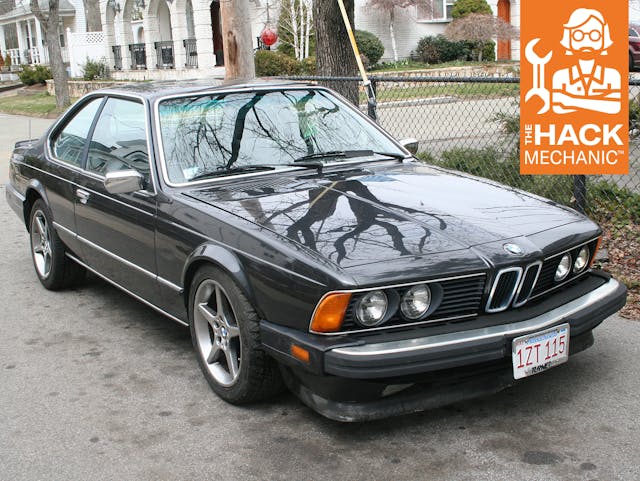
Today, my children, I’m going to tell the story of the time that someone gave Uncle Rob a free black-on-black 1985 BMW 635CSi.
The story beings 11 years ago, when I bought a different ’85 635CSi (here’s an overview of the BMW E24 6 Series “shark”). That one was a rust-free, high-mileage, badly sun-oxidized five-speed car with sport seats. It had died on the seller several times due to an undiagnosed electrical malady and was dead again; he said he strongly suspected the car needed an electronic control unit (ECU). His wife recently had a baby, the car needed go, and he was asking only $500. I told him that if it was indeed rust-free, I’d buy it. I was so interested that when I hopped on eBay and saw an ECU for $60, I snagged it, even though I didn’t own the car yet.

The next day, I inspected the car, found it to be as rust-free as claimed, and forked over the Benjamins. When I asked the seller for the key, he said, “You understand that it’s dead, right?”
I laughed and said, “Well, I might get lucky.” I turned the key, and the car started right up. I could practically see steam rising out of the seller’s ears. I put my hand on his forearm and gently said, “Look, you know that if the car has an intermittent electrical issue, it will recur on me, right?” He calmed down.
I got the car home and ran it in circles around the block while gradually increasing the electrical load. As some point, with the headlights, air conditioner, and rear-window defroster on, it died. Gotcha! I found that the brushes on the voltage regulator were worn down to nubs. I replaced the regulator and the problem was fixed in minutes. In one of my Boy Scout moments, I called the seller, described what I’d found, and said, “I haven’t filled in the title yet, so I’m going to do for you what I’d want someone to do for me if the tables were turned, and ask you if you want your car back.” He paused and said, “I am so grateful for you having the consideration to ask me, but with the new baby, the car needs to be gone. Whether it’s you for $500, or the next guy for $1500, it really doesn’t matter. But really, thanks.”
I sorted out the car and drove it until the Great Mini-Cleansing of 2011, when the 12,000-square-foot warehouse in which I worked (and in which I stashed several cars) abruptly closed and I thought I was going to lose my job. I sold the 635CSi, along with a ratty 2002 and my ’82 Porsche 911SC—an error in judgment and timing from which I have never quite recovered. I never even opened the box with the ECU that I’d bought. It sat on a shelf in the basement for seven years.
And that is where we enter the story of the free 635CSi …
In the fall of 2017, my youngest son’s girlfriend told me that her father was having trouble with an old BMW he owned and wanted to know if he could seek my advice. I spoke with him and learned that he was mainly a Mercedes guy, but in an odd bit of symmetry via his children’s significant others, he’d bought an ’85 635CSi (not the same one I’d sold) from the father of his son’s girlfriend. He liked the car a lot, but it had died on him, was now at the shop that worked on his Mercedes, and they were stumped. He asked me if I’d be willing to talk with the mechanic. I explained that I’m not a pro, and that I’m really hesitant to sanity-check a professional who almost certainly knows more than I do.
However, it dawned on me that if the shop reached the point where they suspected the ECU, I did, in fact, still have a spare one somewhere in my basement, and the mechanic was more than welcome to it. He swung by to pick it up when I wasn’t around, so handing over the ECU is now on my wife’s résumé.
I didn’t hear anything else about the car or the ECU for a few months. Then I got an e-mail from my son’s girlfriend’s father. “It looks like my 1985 635CSi continues to defy my mechanic, so I’m close to pulling the plug. If there is any chance you might have a use for it, or parts of it, I’d be most pleased to transfer the car to the Siegel garage as a gift. You have all been so good for Abbey [his daughter], and this will be our very small token of appreciation for your generosity. I’m sure we could easily have AAA tow it to Newton, or you could assess it here before deciding.”
I had two reactions. The first was that by paying it forward and offering the first 635CSi owner his car back, I was grateful to have come to a place in my life where someone was now offering me a free 635CSis. The second was that the only thing more expensive than a free dead German car is a free boat.
I knew that his car was a five-speed with a valuable Getrag 265 gearbox, and thus, on paper, it would be worth taking even if it were rusty beyond redemption, but with everything else on my plate, the idea of parting out a car to pull a transmission I didn’t even need was less than appealing. So I thanked him for his generosity and very tactfully explained that, not to look a gift horse in the mouth or anything, I thought that the responsible thing to do was to lay eyeballs on the car and see what I’d be signing up for. He understood perfectly and offered that we meet at the mechanic’s shop. That way I could see the car and have the mechanic explain everything he’d tried. So I drove about an hour to where the car was in Rowley, Massachusetts. It was sitting on the edge of the parking lot.
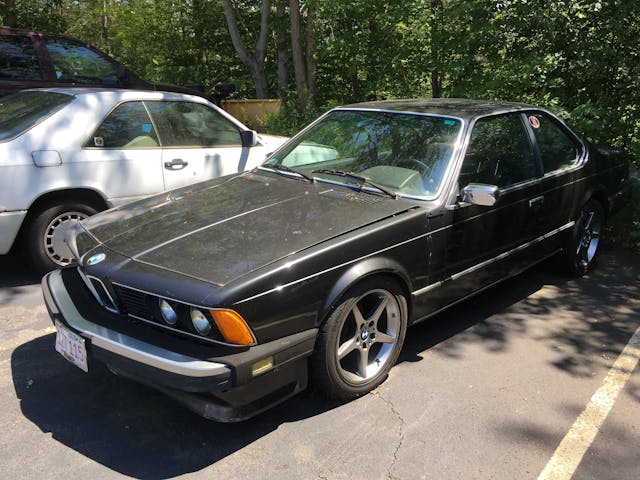
Diamond Black with a black non-sport interior, it looked better than I expected. Though a little forlorn and worse for the wear (with a sagging front air dam), there was a positive spark of energy between us—as opposed to an animal-shelter-like situation where the dog is snarling in the back of its cage while the manager is trying to convince you that it’s “good with children.”
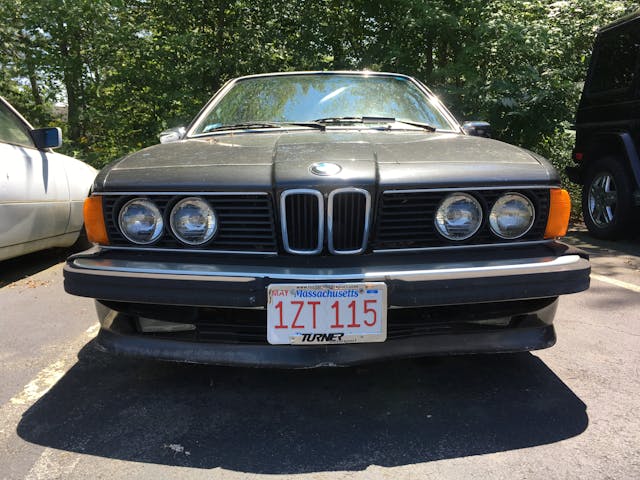
There was a little rust bubbling on the rear wheel arches and rust around the plug on the passenger floor, but clearly it wasn’t a parts car. The ECU—was it mine?—was hanging from the glovebox, and the fan and viscous clutch were in the trunk, but other than that, it seemed largely together. There seemed to be ample space between the car and the abyss.
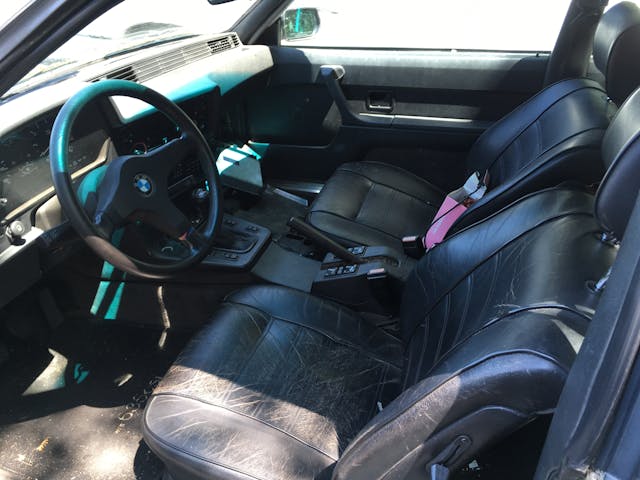
The shop owner came out. The car, he said, was presenting two different problems. Initially there was a no-spark condition, which they’d largely solved by fiddling with the main relay and changing both crank sensors. The second problem was that once the car started, it ran eye-wateringly rich. He explained that they made sure that the cold-start valve wasn’t stuck open, the wiring harness to the injectors wasn’t grounded, and tested the pinouts on the ECU (yes, they’d swapped mine—it was in the car now, but to no avail). Whatever was wrong with the car, clearly it wasn’t going to be as simple as it was to swap the voltage regulator was on the last ’85 635CSi.
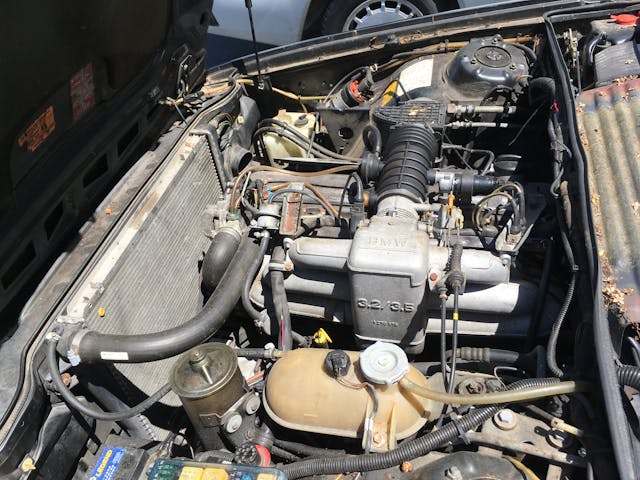
I thought for a bit and did what most of you would’ve done: I graciously accepted his offer and took the car. The owner and I joked that, in German, there must be a deliciously long complicated very precise word describing the relationship that the previous owner and I have through the car (“gift from my son’s girlfriend’s father’s son’s girlfriend’s father” translates, if you remove the spaces, as geschenkvonmeinemsohnfreundinvatervatersohnfreundin, which may not be technically correct, but has the right gestalt).
As offered, he had AAA tow it to my driveway. I moved my Winnebago Rialta and rolled the black shark to the end, then parked the Rialta in front of it, which was my way of saying, “Sweet dreams, see ya in the spring.”
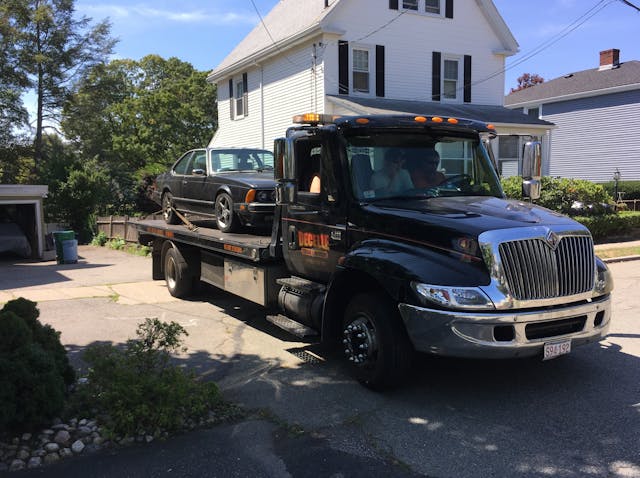
Sometime in mid-April 2018, when the snow had finally melted off the car, I approached the black shark. What I saw wasn’t pretty.
The car had been left in the state that happens when a client says “stop” to a mechanic and no graceful buttoning-up is performed. The ECU was still hanging down from under the dash. The glovebox was in the back seat, along with the fan and shroud (the back seat was apparently the place where the cool wayward components were hanging out, drinking beer and smoking Marlboros). The cap and rotor were on the front floor, and the plug wires were all hanging in front of their exposed recess at the front of the engine. The air flow meter and air cleaner were in the trunk. I felt bad that I’d let the car sit like this through the winter.
Further, I found several places where the wiring harness had been sliced open. I surmised that the mechanic was using a site like AllData and probing key wires for the presence of voltage (this was later confirmed by finding an AllData printout in the glovebox). I found this curious; cutting open a wiring harness is the last thing I would do, not the first. I thought that if this was the level of intervention being applied by a professional, something must really be fubar’d.
I was about to re-install the Motronic rotor and cap when I looked at them closely. The cap had a fair amount of corrosion on the contacts for the coil and plug wires, but it was the rotor that gave me pause. The center contact—the flat spot against which the spring-loaded contact from the cap presses—is supposed to be about three-eighths of an inch across, but instead, what I saw was only the size of a pencil lead.
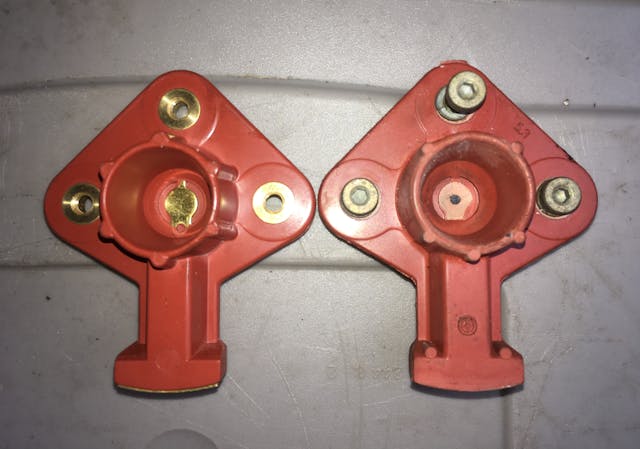
I thought that clearly that could be the source of the no-start and dying problems right there. I’ve read horrible things about cheap off-brand cap/rotor sets, so I spent the $75 for proper OEM Brembi components. While I was waiting for the parts to arrive, I re-mounted the ECU and put the glovebox back together.
When the cap and rotor came, I installed them, then re-installed the fan and shroud. I verified that the engine had oil that didn’t look too disgusting—in fact, it looked recently changed—confirmed that the gas didn’t smell like varnish, connected the air flow meter, removed the flat-lined battery, took a battery out one of my other cars and dropped it in, opened the air flow meter’s door, gave it a good blast of starting fluid, and turned the key.
Vroom, baby.
Well, OK!
That vroom, though, was quite loud. Feeling with my hands, I easily traced the source of the noise to a major exhaust leak coming from between one of the exhaust manifolds and its attached headpipe.
M30 engines are not known for champagne-glass-on-the-engine-smooth idle, but this one seemed especially labored. And when I revved it in the driveway, as soon as it came off the idle switch, it stumbled pretty badly. Still, a quick look under the nose confirmed that there were no copious puddles of anything. This was really pretty darn good for a first encounter.
The next day I started the black shark and backed it out of the spot where it had been sitting since the fall. The brakes cracked and groaned as the rotors, initially stuck to the pads from their outside sojourn, broke free and began turning. So, out of the driveway, maybe around the block? Yeah. Ten feet, then 50. Hey, look—Black Shark is swimming! I could hear and feel the pads wiping the rust off the rotors as I applied the brakes. The car drove and shifted fine and didn’t obviously pull during braking. And when I put my foot into it, it moved out right quick.
But at low-rpm steady throttle, something was clearly wrong, as the car hesitated and stumbled, amplified by the loud exhaust. Part of me thought, “It’s running—sell it right now!” but sometimes I can’t resist a challenge.
All sorts of running problems on Motronic cars can come from vacuum leaks and a bad temperature sensor, but the intake bellows weren’t split, the vacuum hoses all appeared intact, and replacing the temperature sensor made no difference.
I spoke with a friend who advised that one or more of the injectors might be clogged or otherwise defective. I unplugged each injector and checked that none of the solenoids were burned out by using a multimeter to verify that the impedance was about 16 ohms on each. I listened to each injector with a mechanic’s screwdriver and made sure that I could hear all of them opening and closing. Unfortunately, those steps don’t tell you if the injectors are spraying, or what the spray patterns are. I tried spraying carb cleaner into a vacuum line while tapping on the injectors with a screwdriver but detected no change. I thought about removing and cleaning the injectors, but then found someone on eBay (with a good feedback rating) selling rebuilt sets of six Bosch injectors—the newer-style ones with four nozzles instead of one—for $80. I loved the idea of simply yanking the fuel rail and replacing all six injectors with cleaned and tested known-good ones. In they went.
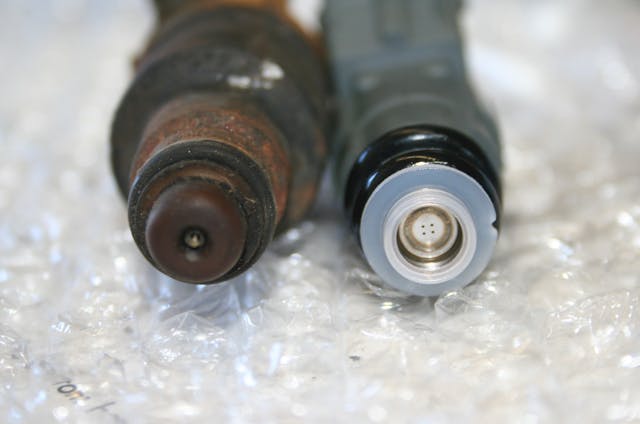
I also put the car up on the lift and dropped the headpipes from the exhaust manifold. What came out was laughable; there are supposed to be triangular gaskets with thin metal sealing rings in the center, but on both of the headpipes, just about all that was left was the ring.
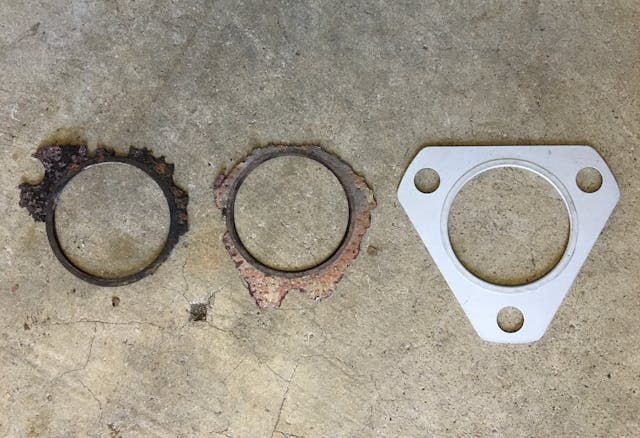
With the new injectors installed and the exhaust quieted down, the car was much better-mannered. It stumbled and hesitated less and was far quieter, but something still seemed slightly amiss at low-to-mid-rpm steady throttle. The problem seemed so load-specific that I suspected the air flow meter. These are basically just resistance-track devices whose functionality you can test with a multimeter (and I did), but when I examined mine, I was surprised to find that, instead of saying Bosch, it had a script-in-oval Ford logo. I ran the part number, and it appeared to be a Cardone-rebuilt unit that cross-references between BMW 3.5 M30-equipped cars and mid-1980s Ford Mustangs and Thunderbirds.
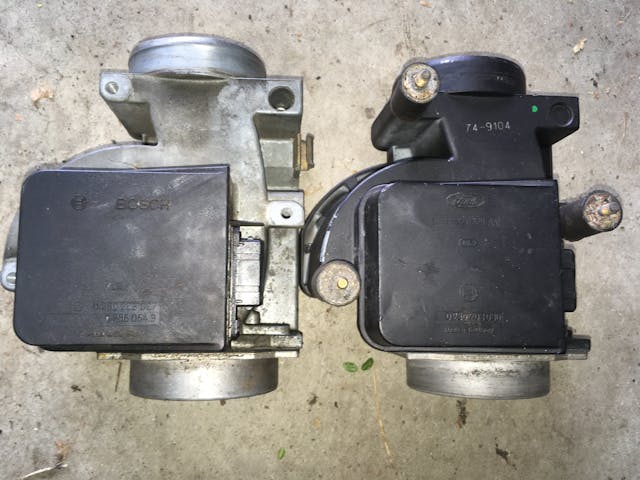
While this swap didn’t strike me as inherently implausible—indeed, I believe that the injectors I’d installed cross-reference to a Mustang—it was not a swap that I’d heard of, nor had I found it on the forums. Through a friend who parts out BMWs, I obtained the correct air flow meter in two days for 60 bucks, installed it, and drove the car. The even-throttle hesitation and stumbling completely vanished.
With the shiny black paint and the 1000 Miglia MM11 17-inch wheels, the car certainly had that 635CSi presence. And driving-wise, it was surprisingly good. Clearly, someone had loved this car; it had Bilsteins all around and what looked like Suspension Techniques springs and sway bars. The ride was firm but surprisingly free of toolbox-in-the-trunk-like thunks, clunks, and rattles. The gearshift was beautifully tight.
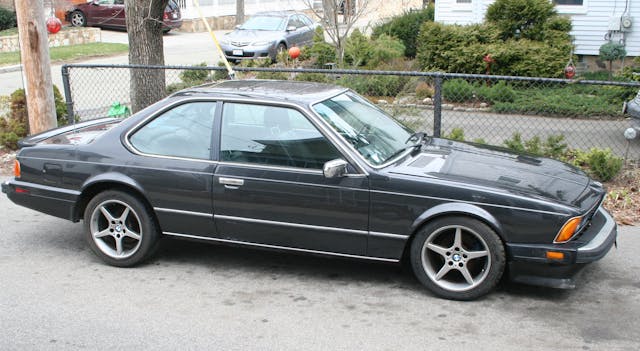
But the car did have a little rust and a lengthy punch list. The air dam was hanging low. Neither the speedometer nor the tach worked. The ABS light was on. It was dripping a little power steering fluid. The stereo seemed to only turn on at its whim. The A/C was functional and had R134a charging fittings, indicating that someone had converted it at some point, but it blew barely cold. The beefy 235/45-17 tires rubbed the front fenders on tight turns. The back end seemed a bit high, as if the rear springs were mismatched with the fronts. The driver’s-side door glass was misaligned, requiring you to roll the window up while the door was closed.
Now, I already had another E24—a silver ’79 Euro 635CSi with black stripes that I’m quite smitten with—so the car’s destiny was not with me. I was just a caretaker. I decided that, having gotten the car for free, and not had to spend a lot to get it running well, it was better to pass it on now at a good price to an enthusiast on a budget rather than try to get the last dollar out of it. I photographed the car thoroughly, described it honestly with the kind of ad I take pride in writing (the kind that forestalls someone driving for two hours, looking at it, and 30 seconds later, saying, “Well that was a complete waste of time”), priced it at $3750, and floated it on Facebook.
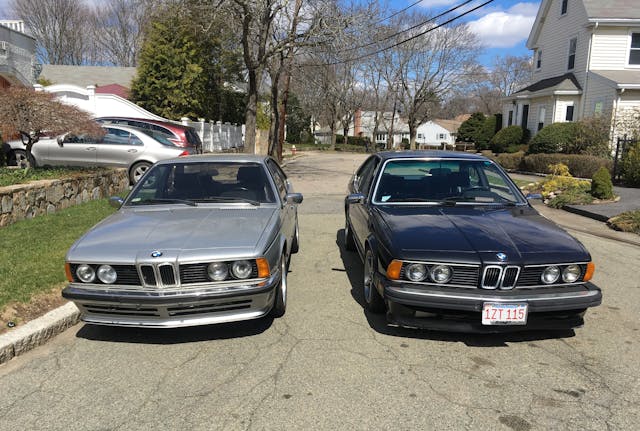
The next evening, I got a call from a young man in Nashua who said that he’d buy it sight-unseen at my asking price. He complimented me on the honesty of my ad, said that he had a couple of E30s and E46s, was looking to get into a shark, and understood that the car had a punch list. After we got off the phone, he sent me a deposit through PayPal, and bought it the next day.
As it happened, he was so taken with the car that he drove it, along with me and my traveling companions, on a 2000-mile round trip to “The Vintage,” the annual BMW event in Asheville, North Carolina. Other than needing to correct a belt slippage issue, the car ran fine.
It really worked out perfectly. The car was saved from an uncertain fate, it was revived and put into the hands of an enthusiast, and the money was immediately allocated to my just front-burnered Lotus Europa Twin Cam Special project.
A few months later, I saw on the new owner’s Facebook page that the buyer was getting married and selling the car. It popped up once on my radar after that, but then sank beneath the ethernet waves.
Black Shark (or the earlier ’85 635CSi, for that matter) isn’t one of those cars that I regret selling and pine away for like my ’82 911SC. Rather, I feel like fate put us together for a short time, and I played my part.
Anyone have a free Lotus Elan +2 S130? I think I’ve, you know, earned it.
***
Rob Siegel has been writing a column (The Hack Mechanic™) for BMW CCA Roundel magazine for 34 years and is the author of seven automotive books. His new book, The Lotus Chronicles: One man’s sordid tale of passion and madness resurrecting a 40-year-dead Lotus Europa Twin Cam Special, is now available on Amazon (as are his other books), or you can order personally-inscribed copies from Rob’s website, robsiegel.com.

